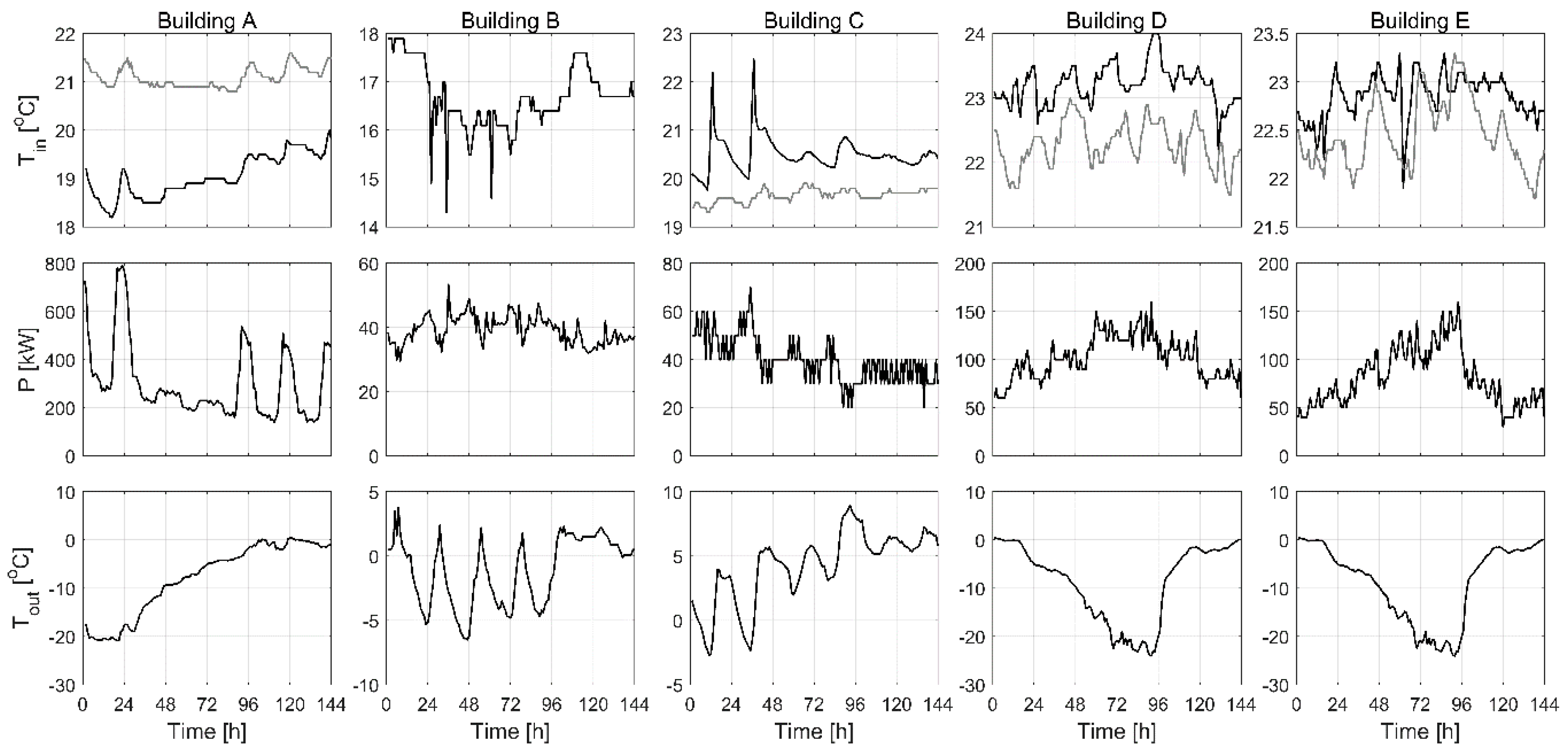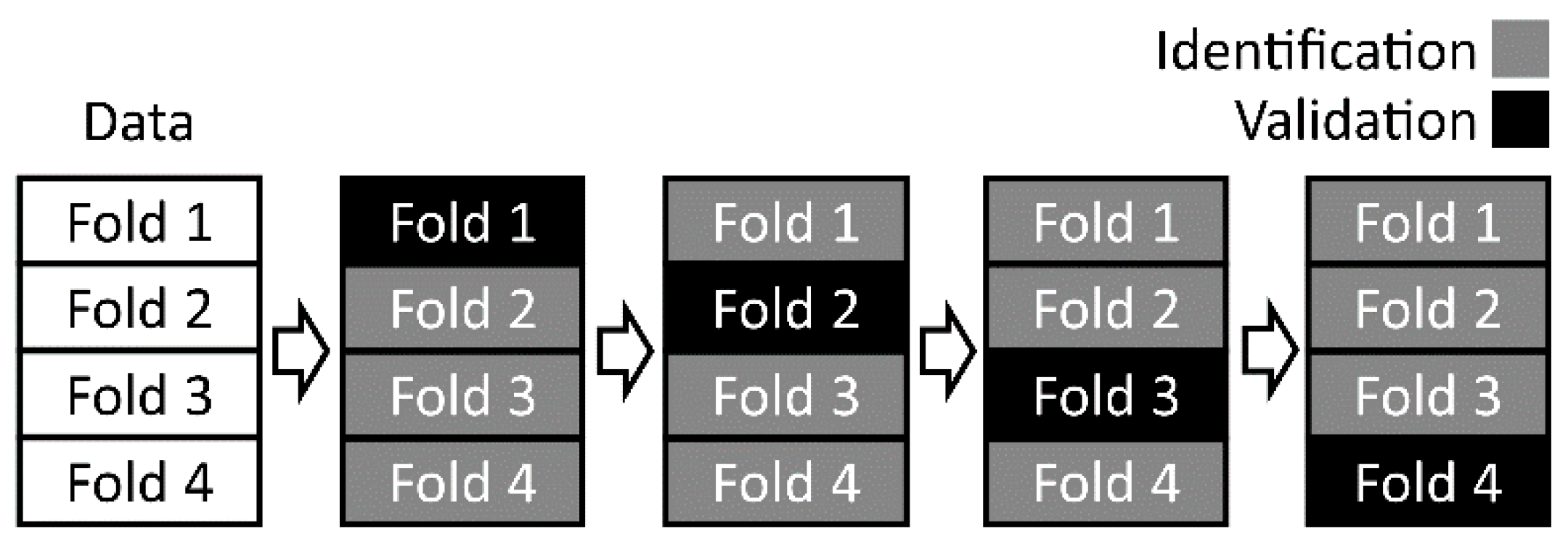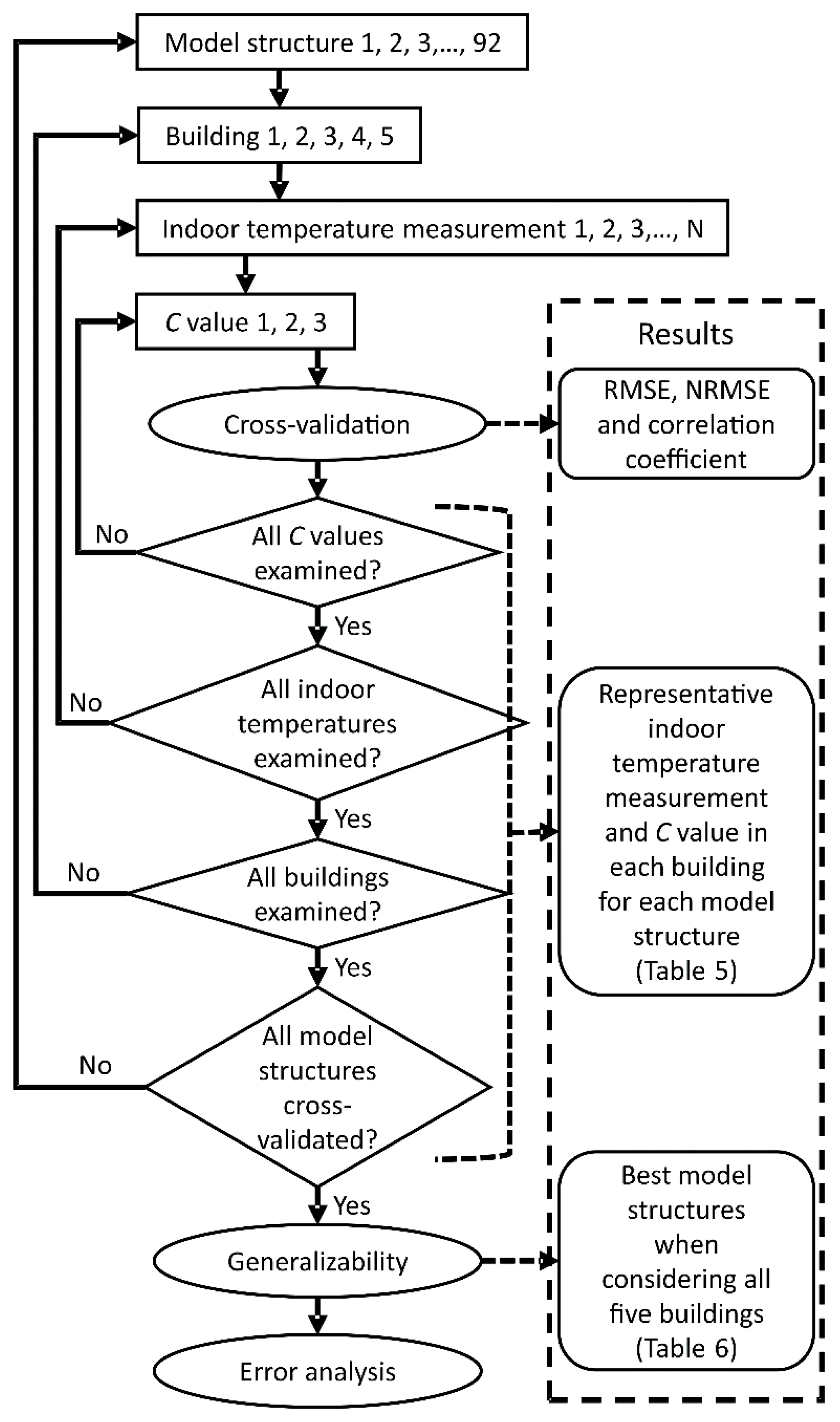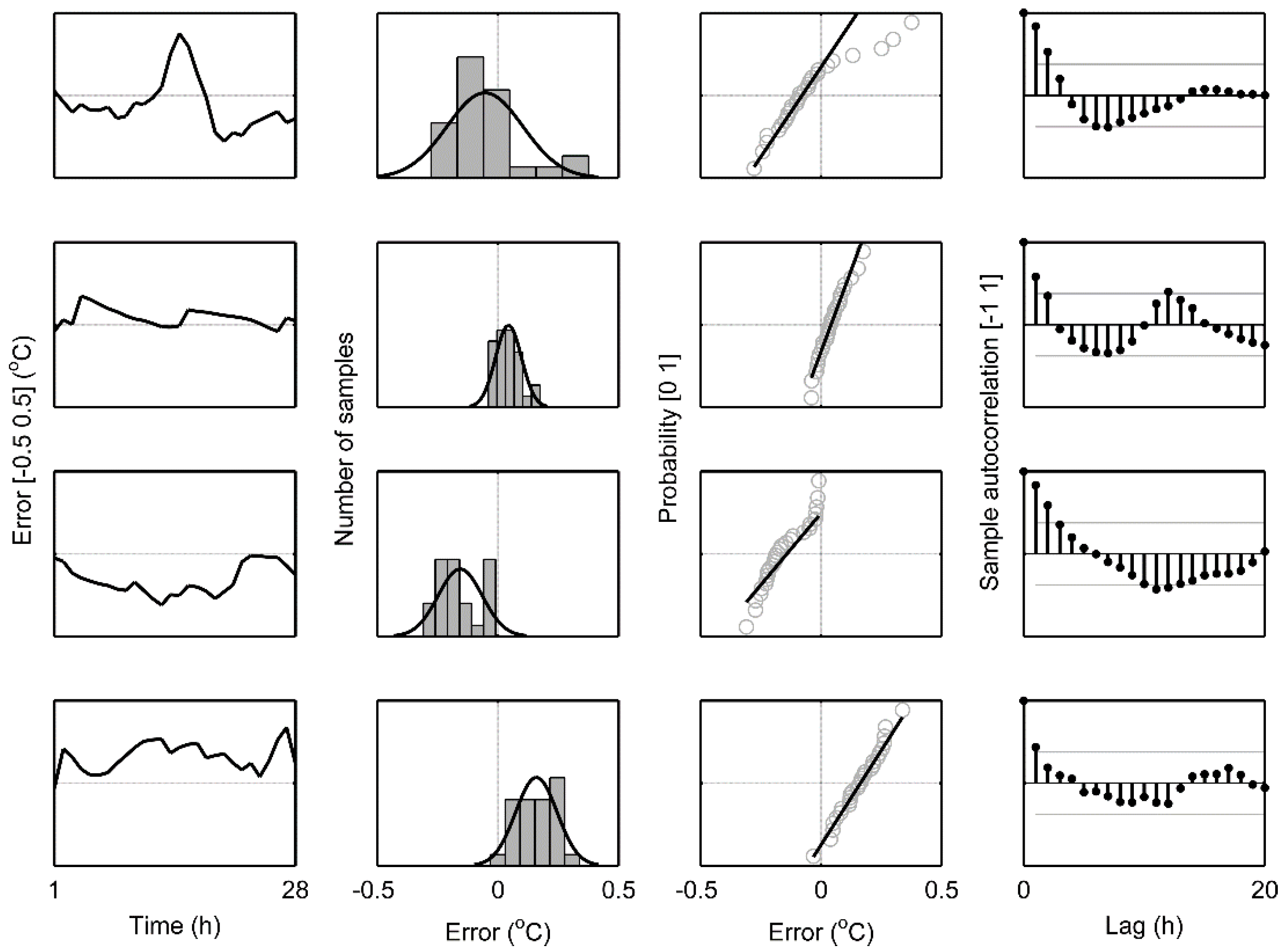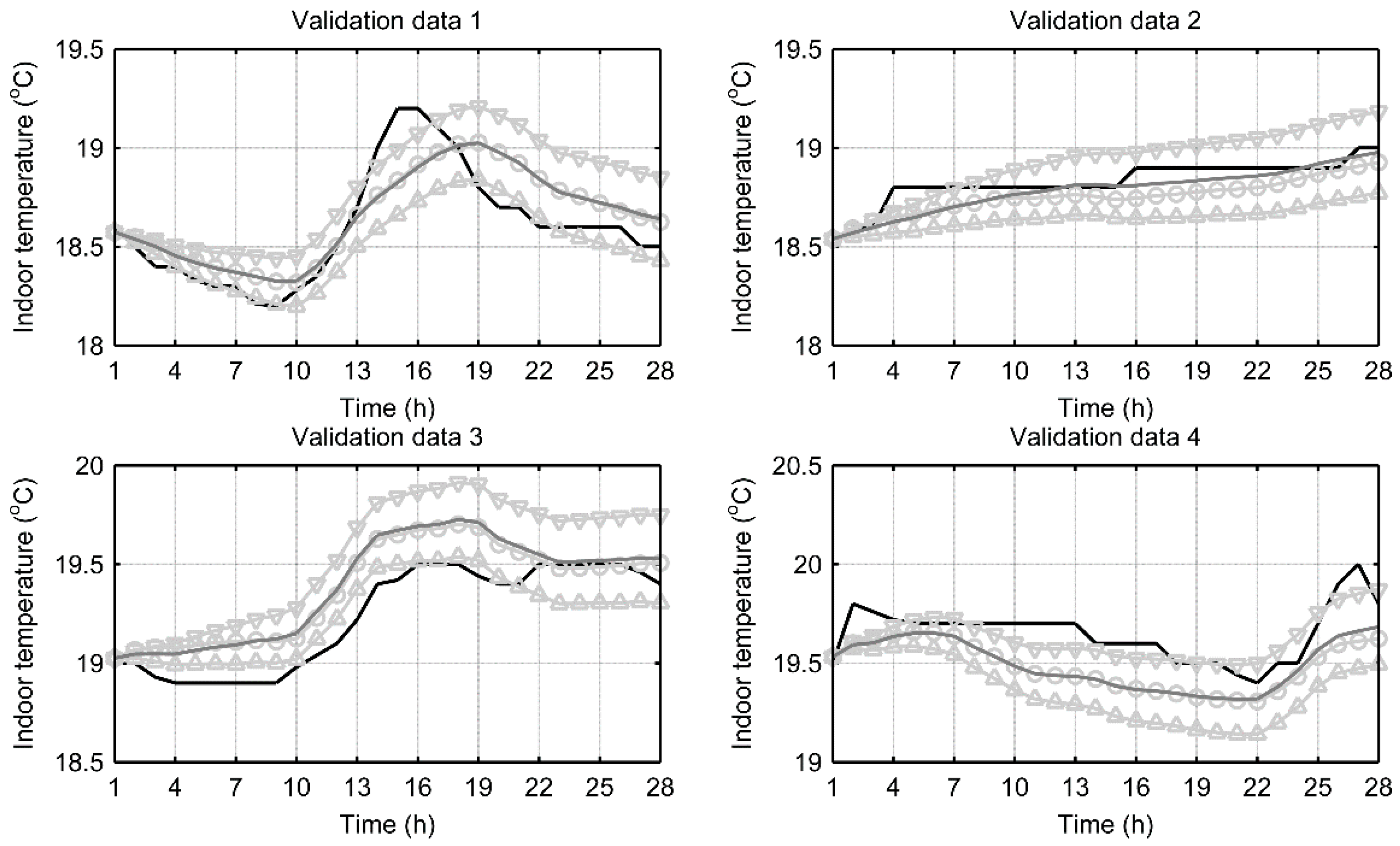1. Introduction
Buildings still use 20–40% of the world’s total energy consumption and Heating, Ventilation and Air Conditioning (HVAC) account almost half of this energy [
1]. At the same time, the heating energy is predominantly based on fossil fuels [
2]. Considering this, it is the most important to implement new energy efficiency measures for the building sector. In this article, an identification and validation of a novel dynamic model for predicting the indoor temperatures in large buildings is presented. This modelling approach is argued to provide a key tool for demand side management to enable the predictive optimization of the heat demand at district and city level.
As the requirements for energy efficiency are becoming stricter, it is no longer sufficient to consider buildings as isolated elements in energy systems [
3]. They have to be considered as active players having storage capabilities and even their own energy production. Therefore, buildings have to be taken into consideration when developing new control and optimization schemes for district heating systems. A concept for optimizing the heat demand in district heating systems has been proposed by the authors in [
4] and preliminary results have shown that significant energy savings and peak load cuts can be achieved [
4,
5]. The concept approaches the subject by predicting the heat consumption and then optimizing the heat production utilizing demand side management. In this context, the thermal mass of buildings plays a major role for controls towards lower energy usage [
6,
7] and can offer advantage over centralized storage solutions [
8]. However, its use is a challenge due to the slow dynamics of heat storage resulting in time delays [
9]. Systems with large delays are generally harder to control and require model-based control. At the same time, maintaining the indoor temperature at an acceptable level is important as the control actions should ensure the quality of the living conditions for the residents. Therefore, a mathematical model for the indoor temperature of a building is critical for predicting the energy demand and for enabling control and optimization strategies aiming at higher energy efficiency [
10]. Such a model has to be easily reproducible for multiple buildings to achieve wide impact with energy optimization actions. This sets requirements for the simplicity and ease of parametrization of the model. The straightforward implementation in real applications should also be kept in mind. In modern automation, the cost of implementation work plays a key role while the cost of the hardware is decreasing.
Zhao and Magoulès [
11], Kramer et al. [
12] and Foucquier et al. [
13] have all presented extensive reviews of the building modelling literature. This article addresses especially the modelling and prediction of the indoor temperature in buildings. These models are typically based either on physical principles or they are data driven or a combination of both. Models based on physical principles can vary largely from extremely complex to more simplified structures with respect to the number of parameters and variables [
14,
15,
16,
17] but they usually need detailed information on the building characteristics and are in general too computationally heavy to be effectively used for control purposes. On the other hand, data driven models [
18,
19,
20,
21,
22,
23,
24,
25,
26,
27,
28] are based solely on measurements and are typically identified without information on the physical nature of the building properties. Hybrid or grey box models are a combination of data driven and physical modelling approaches [
29,
30,
31,
32,
33,
34,
35]. This model type needs sufficient amount of measurement data for parameter identification and some information about the properties of the building. Generally, the methodology adopts a simplified physical model structure and then its parameters are estimated using measured data [
36,
37].
For the data driven and hybrid models the data acquisition for the identification of the model and for the estimation of the model parameters is an important issue. If physical parameters are used in the model, they could be calculated using information on building characteristics, but this information is not always easily available. One widely used method for obtaining data for parameter estimation is to apply a physical model for the building to generate an artificial data set [
38,
39,
40,
41,
42,
43,
44]. This method was also recently used in [
45] where a calibrated EnergyPlus model was utilized to train a simplified model. This kind of data collection would be very time consuming and impractical in case of hundreds or thousands of buildings. Other ways to get a representative data sets for the model identification include the use of data with minimum and maximum historical records [
21] or collecting data by performing step response tests [
46]. Also, many of the reported studies have acquired data from a particular test building for the model identification [
47,
48,
49,
50,
51,
52]. All these ways can be used to collect data although it can be laborious and time consuming. Also the representativeness of the data and the resulting performance of the model in real buildings at normal operating conditions may remain questionable. This is especially the issue when using physical models to generate the data [
53].
For wide use of any indoor temperature model, it should be applicable to different types of buildings with minimum extra implementation work. However, almost all of the reported research discussed above focus on a single building for the development and validation of the model. Furthermore, many of the models presented in previous studies needed detailed information about the building properties and large amount of representative measurements together with many parameters. All of this would increase the complexity and the implementation work of the models thus limiting their application to different buildings in real environments. If the models are only tested in one building, it is very much possible that they cannot be transferred directly to another building. It is not certain if the order of the linear model or the number of hidden layers of neurons of the ANN model can be the same in different buildings, if only one building is used for the model development. Then it comes to the amount of work needed to transfer these models into the different buildings. If the model is to be used only to control an individual building, the implementation time will not necessarily be an issue. However, as the intention of the authors is to perform the optimization of the heating demand at district and city level, the short implementation time for the model is crucial. Days of modelling work on one building is not acceptable if there are hundreds or thousands of buildings that need to be modelled.
To overcome the modelling issues presented above, a new dynamic modelling approach to predict the indoor temperature is proposed. To ensure the model generalizability to the whole building stock together with the reasonable prediction accuracy, the main supporting ideas are:
To combine easily available, existing real measurements, building information and tabular values while minimizing the number of model parameters and inputs,
To apply the modelling approach for multiple buildings to validate the generalizability.
Motivation for the proposed modelling approach comes from the fact that it has to be easily implemented in a wide range of energy management systems to enable the city level optimization of the heat demand. In this context, fewer amount of parameters, easily available measurements and generalizable model structure are assumed to make the parameter identification of the model easy in comparison to present modelling methods. The above mentioned model properties would allow the wide application of the model as it is intended to be adaptable to multiple buildings [
4].
In the next section, the building information and measurement data is described. The proposed modelling approach and the performance analysis for the model are explained in
Section 3. The model identification and validation results are presented in
Section 4 and the application of the model in the optimization of the heat demand is discussed in
Section 5. Finally, the results are discussed in
Section 6 and
Section 7 contains our conclusions.
6. Discussion
It is worth noting that the modelling results presented in this article were achieved with a fairly small amount of measured data. Only 100 h of data was used for the estimation of the model parameters. Also, the data was recorded at the time when the buildings were in normal use. This included the actions of the automatic heating controls of the buildings. Furthermore, the energy used for hot water heating was not excluded from the heating power measurements, which could explain some of the modelling error. Although there were multiple indoor temperature sensors in the studied buildings, the final chosen sensor position may not be the optimal one. On that regard, it is remarkable that the indoor temperature measured inside an apartment could be used for the developed model as a representative temperature. Moreover, the C and U values were calculated using tabular values, which naturally introduces some error, and although three different C values were investigated the selected ones might not be the optimal values. Nevertheless, based on the modelling results, it can be concluded that this kind of data contains enough information to achieve acceptable model performance according to the presented testing criteria.
All the buildings studied in this research were large buildings, namely a school, a municipal hall and apartment buildings. Therefore, to assess the applicability of the model for smaller constructions, like detached houses, would require further studies. In [
57], where detached houses were studied, significant consumption peaks in heat consumption due to domestic hot water were seen. In large buildings, the hot water consumption is largely in the noise. It is possible that the domestic hot water consumption will then have a more significant effect on the model performance in detached houses.
The presented model was identified without measuring the effects of the sun or wind to keep the number of model inputs as low as possible. However, Kapetanakis et al. [
58] also found that the wind speed has no significant correlation to the heating load of the buildings. In the present study, the effect of the sun on the indoor temperature was investigated by calculating correlation between the modelling error RMSE and sunny weather. For all the buildings, the correlation was below 0.5 indicating no significant correlation. Furthermore, for four of the buildings correlation was also negative. In conclusion, there appeared to be no significant effect from the sun on the indoor temperature that the developed model could not account for. However, the inclusion of the solar heat gains as an input to the model and its impact on modelling accuracy should be investigated more thoroughly in future works. It should be noted that all the studied buildings are located in the northern hemisphere and relatively near the Arctic Circle. Therefore, the developed model can only be expected to work under similar conditions. In future works, the performance of the model in buildings under different climatic conditions should be studied.
Another challenging topic for future works is the application of the model in cases when the indoor temperature measurement is not available allowing even wider application of the model. Lack of the indoor temperature measurement is particularly the case in many older buildings. Also, the calculation of the physical model parameters needs information on building geometry that could be hard to gather for a large number of buildings, therefore more efficient ways to calculate or estimate these parameters are needed and will be looked into in future works.
Remarkably, the clear correlation between the measured indoor temperatures and its estimated values justifies the selected model structure. It then follows that, at least in large buildings, the indoor temperature variation can be modelled by the same parametrized version of the heat transfer equation (Equation (1)). These conclusions lay a foundation for the future studies where the developed model will be applied for the predictive optimization of the heat demand in a large number of buildings. This will include the optimization of the heating power of a single building and, more importantly, the focus then is on the simultaneous optimization and scheduling of multiple buildings, say from 200 to 500, enabled by the indicated generalizability potential of the presented modelling approach.
